CHAPTER V.
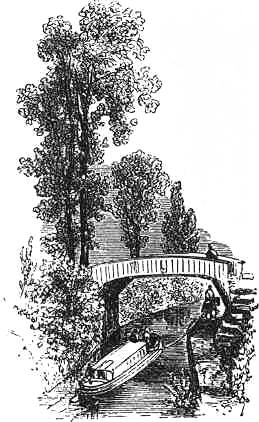 For
the twofold purpose of affording water-power for mills, and providing still
water for the boats of the Champlain Canal to cross, the Saratoga Dam is constructed
at Fort Miller, three miles below the rapids. The dam forms an elbow in the
middle of the stream, and is about 1,400 feet in length. Below it are considerable
rapids; just above it is a bridge, which has a carriage-way for the public
use, and a narrower passage for the horses that draw the canal boats. These
vessels float safely on the usually still water of the river, but sometimes,
when the stream is very full, the passage is attended with some difficulty,
if not danger, on account of the strong though sluggish current. When we visited
the spot, a large-class boat lay wrecked in the rapids below, having gone
over the dam the day before.
For
the twofold purpose of affording water-power for mills, and providing still
water for the boats of the Champlain Canal to cross, the Saratoga Dam is constructed
at Fort Miller, three miles below the rapids. The dam forms an elbow in the
middle of the stream, and is about 1,400 feet in length. Below it are considerable
rapids; just above it is a bridge, which has a carriage-way for the public
use, and a narrower passage for the horses that draw the canal boats. These
vessels float safely on the usually still water of the river, but sometimes,
when the stream is very full, the passage is attended with some difficulty,
if not danger, on account of the strong though sluggish current. When we visited
the spot, a large-class boat lay wrecked in the rapids below, having gone
over the dam the day before.
The country in this vicinity is beautiful: the valley is narrow, and the hills, on the eastern side especially, rise one above the other in the landscape, until the view is bounded by a broken mountain range beyond. Here we crossed the river upon the canal bridge, and rode down to the month of the Batten-Kill, near where it enters the Hudson, to visit the spot--on the plain just above its mouth--where the army of Burgoyne lay encamped, before he crossed the Hudson to engage in those conflicts at Bemis's Heights, which resulted in his discomfiture and captivity. There he established a slaughter-yard; and it is said that the fertility imparted to the soil by the blood and offal left there was visible in its effects upon the crops raised thereon for more than sixty years afterwards.
The Batten-Kill is a shallow and rapid stream, and one of the
largest of the tributaries of the Hudson, 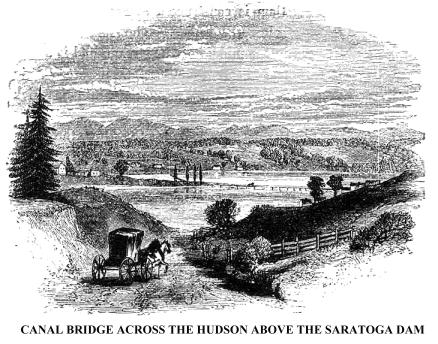 flowing
in from the eastward. It rises in the State of Vermont, and, before leaving
the borders of that commonwealth, receives the Roaring branch: its entire
length is about fifty miles. Within two miles of its mouth are remarkable
rapids and falls, which the tourist should never pass by unseen: the best
point of view is from the bottom of a steep precipice on the southern side
of the stream. The descent is fifty or sixty feet, very difficult, and somewhat
dangerous. It was raining copiously when we visited it, which made the descent
still more difficult, for the loose slate and the small sparse shrubbery were
very insecure. Under a shelving black rock on the margin of the abyss into
which the waters pour, we found a good place for observation. The spectacle
was grand. For about three hundred feet above the great fall, the stream rushes
through a narrow rocky chasm, roaring and foaming; and then, in a still narrower
space, it leaps into the dark gulf which has been named the Devil's Caldron,
in a perpendicular fall of almost forty feet. The Indians named these falls
Di-on-on-deh-o-wa, the signification of which we could not learn.
flowing
in from the eastward. It rises in the State of Vermont, and, before leaving
the borders of that commonwealth, receives the Roaring branch: its entire
length is about fifty miles. Within two miles of its mouth are remarkable
rapids and falls, which the tourist should never pass by unseen: the best
point of view is from the bottom of a steep precipice on the southern side
of the stream. The descent is fifty or sixty feet, very difficult, and somewhat
dangerous. It was raining copiously when we visited it, which made the descent
still more difficult, for the loose slate and the small sparse shrubbery were
very insecure. Under a shelving black rock on the margin of the abyss into
which the waters pour, we found a good place for observation. The spectacle
was grand. For about three hundred feet above the great fall, the stream rushes
through a narrow rocky chasm, roaring and foaming; and then, in a still narrower
space, it leaps into the dark gulf which has been named the Devil's Caldron,
in a perpendicular fall of almost forty feet. The Indians named these falls
Di-on-on-deh-o-wa, the signification of which we could not learn.
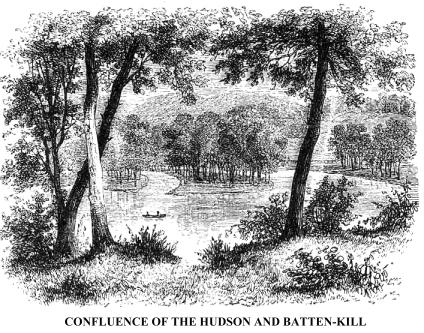 From
the Di-on-on-deh-o-wa we rode to Schuylerville, crossing the Hudson
upon a bridge eight hundred feet in length, just below the site of old Fort
Hardy, and the place where Burgoyne's army laid down their arms. From the
village we went up the western side of the river about a mile, and from a
slight eminence obtained a fine view of the scene where the Batten-Kill enters
the Hudson in two channels, having a fairy-like island between them. The river
is there about six hundred feet in width, and quite deep.
From
the Di-on-on-deh-o-wa we rode to Schuylerville, crossing the Hudson
upon a bridge eight hundred feet in length, just below the site of old Fort
Hardy, and the place where Burgoyne's army laid down their arms. From the
village we went up the western side of the river about a mile, and from a
slight eminence obtained a fine view of the scene where the Batten-Kill enters
the Hudson in two channels, having a fairy-like island between them. The river
is there about six hundred feet in width, and quite deep.
Upon the slope opposite the mouth of the Batten-Kill is the
house of Samuel Marshall, known as the Reidesel House. There, eleven years
before, the writer visited an old lady, ninety-two years of age, who gave
him many interesting 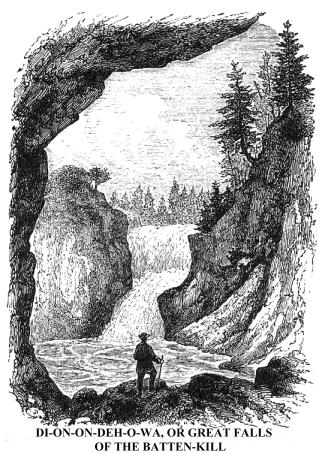 details
of the old war in that vicinity: she died at the age of ninety-six. This house
was made famous in the annals of Burgoyne's unfortunate campaign by a graphic
account of sufferings therein, given by the Baroness Reidesel, wife of the
Brunswick general who commanded the German troops in the British army. She,
with her children and domestics, and a few other women, and wounded officers,
took refuge in this house from the storm of irregular conflict. The Americans,
supposing the British generals were in that house, opened a cannonade upon
it, and all the inmates took refuge in the cellar. "The ladies of the
army who were with me," says the Baroness, "were Mrs. Harnage, a
Mrs. Kennels, the widow of a lieutenant who was killed, and the lady of the
commissary. Major Harnage, his wife, and Mrs. Kennels, made a little room
in a corner, with curtains to it, and wished to do the same for me, but I
preferred being near the door, in case of fire. Not far off my women slept,
and opposite to me three English officers, who, though wounded, were determined
not to be left behind: one of them was
details
of the old war in that vicinity: she died at the age of ninety-six. This house
was made famous in the annals of Burgoyne's unfortunate campaign by a graphic
account of sufferings therein, given by the Baroness Reidesel, wife of the
Brunswick general who commanded the German troops in the British army. She,
with her children and domestics, and a few other women, and wounded officers,
took refuge in this house from the storm of irregular conflict. The Americans,
supposing the British generals were in that house, opened a cannonade upon
it, and all the inmates took refuge in the cellar. "The ladies of the
army who were with me," says the Baroness, "were Mrs. Harnage, a
Mrs. Kennels, the widow of a lieutenant who was killed, and the lady of the
commissary. Major Harnage, his wife, and Mrs. Kennels, made a little room
in a corner, with curtains to it, and wished to do the same for me, but I
preferred being near the door, in case of fire. Not far off my women slept,
and opposite to me three English officers, who, though wounded, were determined
not to be left behind: one of them was 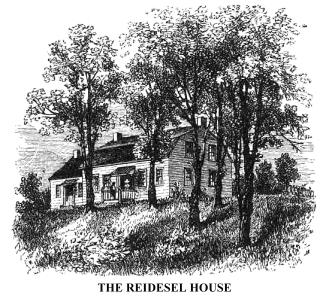 Captain
Green, an aide-de-camp to Major-General Phillips, a very valuable officer
and most agreeable man. They each made me a most sacred promise not to leave
me behind, and, in case of sudden retreat, that they would each of them take
one of my children on his horse; and for myself one of my husband's was in
constant readiness.....The want of water distressed us much; at length we
found a soldier's wife who had courage enough to fetch us some from the river--an
office nobody else would undertake, as the Americans shot at every person
who approached it, but out of respect for her sex they never molested her."
Captain
Green, an aide-de-camp to Major-General Phillips, a very valuable officer
and most agreeable man. They each made me a most sacred promise not to leave
me behind, and, in case of sudden retreat, that they would each of them take
one of my children on his horse; and for myself one of my husband's was in
constant readiness.....The want of water distressed us much; at length we
found a soldier's wife who had courage enough to fetch us some from the river--an
office nobody else would undertake, as the Americans shot at every person
who approached it, but out of respect for her sex they never molested her."
Six days these ladies and their companions remained in that
cellar, when hostilities ceased, 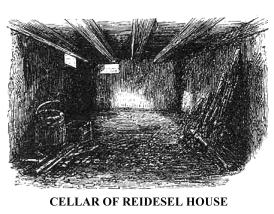 and
the British army surrendered to the Americans.
and
the British army surrendered to the Americans.
The village of Schuylerville is pleasantly situated upon a slope on the western margin of the Upper Hudson valley, on the north bank of the Fish Creek (the outlet of Saratoga Lake), which there leaps to the plain in a series of beautiful cascades, after being released from the labour of turning several mill-wheels. These cascades or rapids commence at the bridge where the public road crosses the creek, and continue for many rods, until a culvert under the Champlain Canal is passed. Viewed from the grounds around the Schuyler mansion, at almost every point, they present very perfect specimens of a picturesque water-course, having considerable strength and volume.
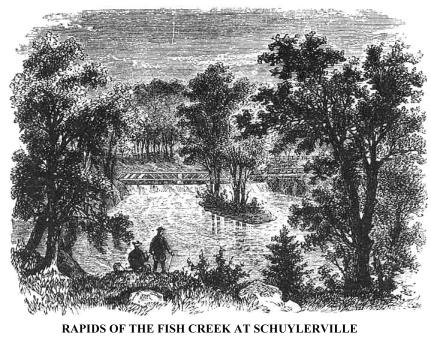 The
village, containing about twelve hundred inhabitants, occupies the site of
General Burgoyne's entrenched camp, at the time when he surrendered to General
Gates, in the autumn of 1777. It was named in honour of General Philip Schuyler,
upon whose broad domain of Saratoga, and in whose presence, the last scenes
in that memorable campaign were performed, and who, for forty years, was a
conspicuous actor in civil and military life in his native State of New York.
The
village, containing about twelve hundred inhabitants, occupies the site of
General Burgoyne's entrenched camp, at the time when he surrendered to General
Gates, in the autumn of 1777. It was named in honour of General Philip Schuyler,
upon whose broad domain of Saratoga, and in whose presence, the last scenes
in that memorable campaign were performed, and who, for forty years, was a
conspicuous actor in civil and military life in his native State of New York.
Upon one of the conical hills on the opposite side of the valley, just below the Batten-Kill, was old Fort Saratoga, written Saratoga in the old records. It was a stockade, weakly garrisoned and with the scattered village of thirty families, of the same name, upon the plain below, was destroyed in the autumn of 1745, by a horde of Frenchmen and Indians, under the noted partisan Marin, whose followers, as we have seen, performed a sanguinary tragedy at Sandy Hill ten years later. They had left Montreal for the purpose of making a foray upon some English settlements on the Connecticut river. It was late in the season, and at Crown Point, on Lake Champlain, the Indians refused to go eastward, because of their lack of preparations for the rigor of winter. On the suggestion of Father Piquet, the French Prefect Apostolique of Canada, who met the expedition at Crown Point, Marin led his white and red savages southward, towards Orange, as Albany was then called by the French, to cut off the advancing English settlements, and bear away what plunder they might obtain. Father Piquet accompanied them, and the invaders fell upon the inhabitants when they were asleep. They burnt the fort and most of the houses, murdered some who resisted, and carried away captive over one hundred men, women, and children.
Upon the south side of the Fish Creek, on the margin of the rapids, stood a brick mansion, pierced near the roof for musketry, and owned and occupied by a kinsman of General Schuyler, bearing the same name. His house was attacked, and in an attempt to defend it he was shot. His body was consumed, with other persons who had escaped to the cellar, when, after plundering the house, the savages set it on fire. That Saratoga estate was bequeathed by the murdered owner to his nephew Philip (the General), who built a country mansion, elegant for the times, near the site of the old one, and occupied it when Burgoyne invaded the valley in 1777. During that invasion the general's house and mills were burned by Burgoyne's orders. It was an act which the British general afterwards lamented, for he soon learned to honour Schuyler as one of the noblest men he had ever met. The mansion was rebuilt immediately after the campaign was over, a few rods from the site of the old one, but in a style much inferior in beauty and expense. It was the general's country-seat (his town residence being in Albany) until his death in 1804, and was still preserved in its original form at the time of our visit, and surrounded by beautiful shady trees, many of which were planted by the master's own hand. It was then the residence of George Strover, Esq., who took pleasure in preserving it as General Schuyler left it. Even some ancient lilac shrubs, now quite lofty trees, gnarled and unsightly, that were in the garden of the old mansion, were cherished as precious mementoes of the past.
An outline sketch of events to which allusion has just been
made is necessary to a full 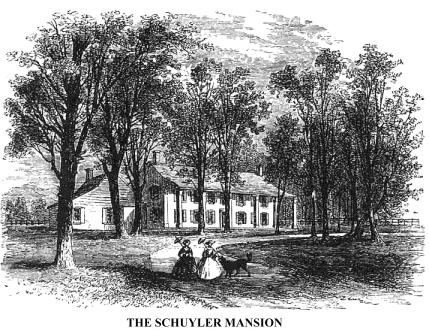 comprehension
of the isolated historical facts with which this portion of our subject abounds.
We will trace it with rapid pencil, and leave the completion of the picture
to the careful historian.
comprehension
of the isolated historical facts with which this portion of our subject abounds.
We will trace it with rapid pencil, and leave the completion of the picture
to the careful historian.
The campaigns of 1775 and 1776, against the rebellions Americans, were fruitless of any satisfactory results. The British cabinet, supported by heavy majorities in both Houses of Parliament, resolved to open the campaign of 1777 with such vigour, and to give to the service in America such material, as should not fail to put down the rebellion by midsummer.
So long as the Republicans remained united, so long as there existed a free communication between Massachusetts and Virginia, or, in other words, between the Eastern and the Middle and Southern States, permanent success of the British arms in America seemed questionable. The rebellion was hydra-headed, springing into new life and vigour suddenly and powerfully, from the inherent energies of union, in places where it seemed to be subdued or destroyed. To sever that union, and to paralyze the vitality dependent thereon, was a paramount consideration of the British Government when planning the campaign of 1777.
General Sir William Howe was then in quiet possession of the city of New York, at the mouth of the Hudson river. A strong British force occupied Rhode Island, and kept watch over the whole eastern coast of New England. Republicans who had invaded Canada had been driven back by Governor Carleton; and nothing remained to complete the separation of the two sections of the American States, but to march an invading army from Canada, secure the strongholds upon Lakes George and Champlain, press forward to Albany, and there form a junction with Howe, whose troops, meanwhile, should have taken possession of the Hudson Highlands, and every place of importance upon that river.
Copyright © 1998, -- 2004. Berry Enterprises. All rights reserved. All items on the site are copyrighted. While we welcome you to use the information provided on this web site by copying it, or downloading it; this information is copyrighted and not to be reproduced for distribution, sale, or profit.